Iconical
Graphemes :
between Speech &
Writing ?
Léo
DUBAL
dubal@archaeometry.org
At the UISPP-CISENP
Colloquium in Paris on 22-23 Octobre 2007
our most recent communication on this topic was
presented in French
under the
title "L'expression par
graphèmes iconiques"
at url http://www.archaeometry.org/graphemes.pdf
At
the 2° Taller Arte Rupestre, at La Habana, April 13-23 2004
our
very first communication on this topic was presented in Spanish
under the title "Grafemas
iconicas, entre palabras y escritura"
at url http://www.archaeometry.org/grafemas.htm,
How does a
language relate to writing ?
Could Rock Art help us to understand how this gap
is bridged ?
The graphical
representation of phonemes reflects
the way the brain puts into words or receives a message.
The complexity of the problem appears once both cerebrals
hemispheres
are taken into account : they are hosting the centres of
different
activities.
Let us summarize the lateralization of some cerebral activities,
relevant to
our topic:
|
Left brain |
Right brain |
|
Time sequence |
Space |
|
Abstraction / Causal thinking |
Emotion / Magical thinking |
To associate Images to
Words, requires therefore to trigger both
hemispheres !
Our hypothesis is that
iconical graphemes (a right brain
activity) acted as
the coach
for the invention and mastering of writing
(a the left
brain activity).
Iconical
graphemes are
stereotyped graphical elements, used into a composition
to represent something extraneous to their own
symbolic value.


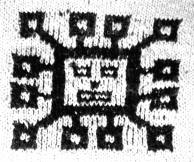
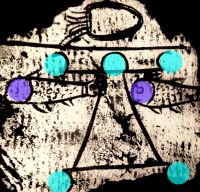
Grapheme # A : Cupule (La Gardette/
France; Helanshan/ China; Bolivia, Cartago/Tunisia).
The Cup-mark
grapheme has been used indistinctly to represent the eyes
and the nose, or, as terminator for the limbs or
the hair, even the head
of Goddess Tanit or the one of two fishes (probably using the same coin
as grapheme's caliber).
In the "INTI" blanket design
this grapheme appears 18 times in
the composite figure of the Sun. Let us note, here, how the
nature
of the support modifies, from round to square, the shape of
the grapheme.
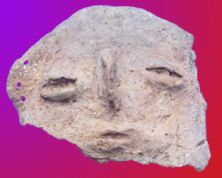
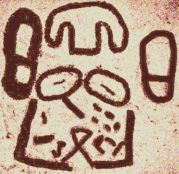
Grapheme # B : Coffee bean (Banes/
Cuba)
The grapheme Grano de café has been used
indifferently to represent eyes
or mouth,
while only for the eyes in the painting (let note the feet
representin,g the
ears andf
the hallucinogenic mushroom, the forehead) .
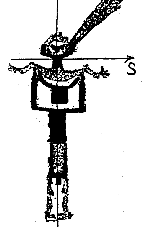
Grapheme # C : Horned head (Mont
Bégo/ France)
This grapheme is used 5 times: for the face, neck, chest, belly and sex.
This
engraving of the
so-called "Chief of tribe" shows how, in a composition,
the use of an iconical grapheme adds a symbolic value for a pastoral
society.
It is interesting that precisely this grapheme has played a key role
in the genesis of our alphabet, giving its shape to
letter A.
Before reviewing further
iconical graphemes, let us first discuss the
links between language and writing.
Such links could be homophonic,
homographic, or acrophonic
1. Homophonic
link,
There,
associated
to one sound, exist at least two spellings,
e.g.:
i) in Anglo-american,
some alpha-numerical graphemes are used, e.g.:
"4u", instead of for you, or
"Xing" instead of CROSSing.
Those unconventional spellings do not add significant
symbolic
values.
ii) in French, hyperlinks
(electronic addresses) are now
frequently enhanced with
the grapheme arrobas, e.g., a pseudo hidden behind cont@ct.
The grapheme "K7", instead of video-cassette,
is widely
used in marketing.
Recently, the TV invited, to take part to a Forum about the
Future,
one hundred and nine pupils, i.e.
"109" which is the homophone of sang neuf (fresh
blood).
Another
homophone
is "la mer" instead of la
mère.
This metaphorical link is nicely exhibited in the
water-painting of a
dream,
with the face of the painter's mother appearing at the surface of the
sea.
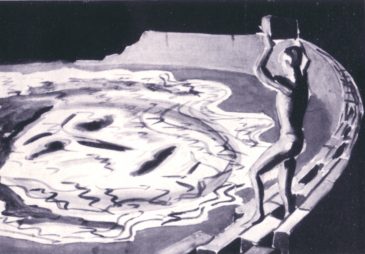
2.
Homographic link
There,
similar
ideograms are pronounced differently.
An interesting case, related to our previous example, is the link
between
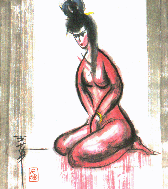
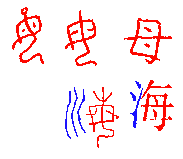
the Chinese character for "mother"
(pronounced,
"mu3" in pinyin),
and the very similar one (with "3 water wavelets" on the left),
meaning "sea" (pronounced
"hai3").
Homographic
links have
been used in poems. e.g.: in Hô
Chi Minh's Prison
Diary:
The 1st
degree reading is: "Take away the sign
for man from the sign for prison.
add to it the sign for probability, that makes
the word nation",
while
a 2nd degree reading
is: "People who come out of
prison can build up the country".
3. Acrophonic
link
The
acrophonic
principle consists in using, as "letter", the graphical sign
depicting an entity
whose noun begins with the phoneme to be represented

In Egyptian writing, e.g. the
hieroglyphic for lion, called
"Lou"
will be used to write names phonetically,
i.e., in ALEXANDER.
The choice of this particular iconical grapheme, to write the sound "L"
in names of kings represent an added symbolic value.
In our opinion, the "Name Age" might have started as
late as 6'000
years ago.

Mn
à
n
The first written testimony of the Name Age is the
"cartouche"
containing the phonogram
of the Egyptian 1st Dynasty King MENA, dated 5'150
Before Present.
It is though difficult
to assert that MENA is already a personal name or still only the noun
of a
social role.
In alphabetic writing, the acrophonic link merges
to etymological roots.
The above mentioned "mother-sea" relationship gives,
in Italian
: MAdre/MAre
and in German : Mutter/Meer.
Review
of some iconical graphemes :





Grapheme # D : v-shape (Corsica / FR; Tafi
del Valle/ Tucuman, AR)
This grapheme is used 12 times on the Corsican stele,
4 times (2X on each side) on one Tucuman statue
menhir,
while, on another, it appears alone.
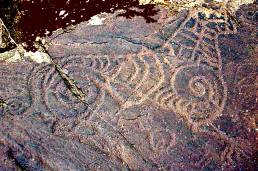
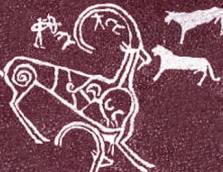
Grapheme # E : Spiral (Helanshan/
China; Siberia)
This "dynamical" grapheme depicts well the muscular strength of the
tiger or... of its prey.
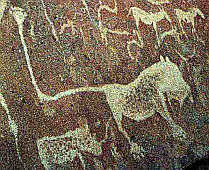
Grapheme # F : Footprint (Twyfelfontein/
Namibia)
This grapheme used to represent the lion's tail enhances the character
of
"trace".
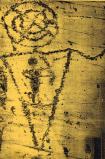
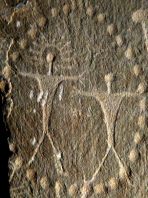
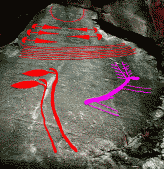
Grapheme #
G : Dagger
& Halberd (Valcamonica/ Italy)
Typical of Chalcolihic Age, this dagger sign is used to represent head
&
trunk.
In 1978, at the Capitello dei due pini, E. Anati noted that, while the
head is
represented by
an antler-necklace, the halberds in leaves-shape seem to
represent the
lower limbs.
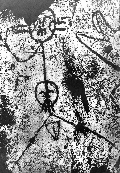
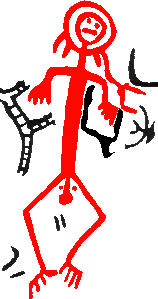
Grapheme # H : Human Face
(Helanshan/ China; Toro
Muerto/ Peru)
While the pubic triangle icon specifies the sex of the
insect-woman of
Helanshan,
the secondary face suggests "pregnancy".
In 1978, in Toro Muerto, A. Núñez
Jiménez noted that
the diamond-shaped legs and sex seem to represent a
face..
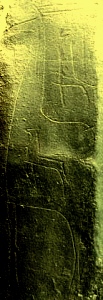
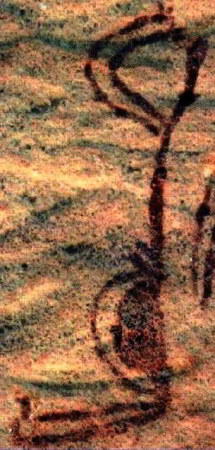
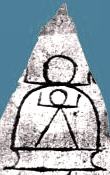
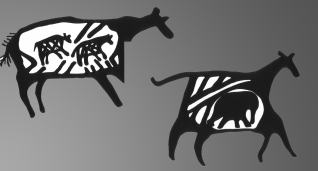
Grapheme # I : Gravid or reduced-size Replicate (
Ojo
Guareña (photo M.Martin)/Spain;
Toca do Caboclinho (photo P.Binant)/Brazil; Carthage/
Tunisia;
Hati Thol /India;)
Replication in reduced size is an interesting grapheme to
represent
pregnancy.
It does not prevent "elephants ", in Hati Thol to
interfere....
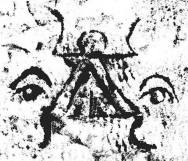
Graphemes # J& K : Goddess Tanit & Solar Disc
& Lunar Crescent (Carthage/
Tunisia)
After the invention of the alphabet, the increasing audacity
of the
engravers produced more
unexpected iconical graphemes. The composite face
contrasts with the
faceless Goddess.
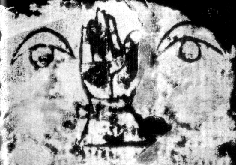

Grapheme # L: Hand (Carthage/
Tunisia;
Coni /1983))
In the composition of a face one could find even a "right"
blessing hand
as a
substitute for the nose, while for the head of a guitar,
the Cuban artist Coni used a "left" hand.
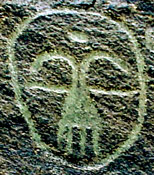
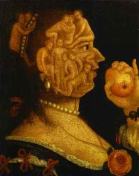
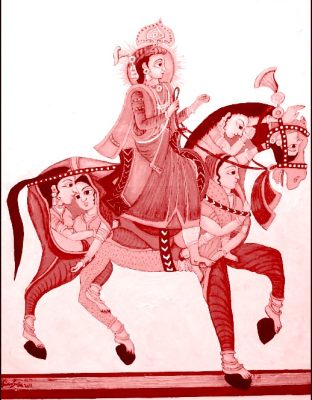
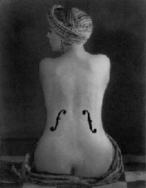
Grapheme # M : Human Body (Helanshan/Ninxia, PRC;
Giuseppe Arcimboldo 1578; Krishna; Man Ray/ 1924)
The composed faces of the Neolithic engravings, or of
Eva and the Apple illustrate the subtle use of
iconical grapheme of human body,
while the outlines of the The violon
d'Ingres suits the taste of the 20th century.
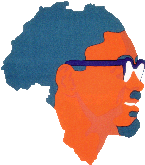
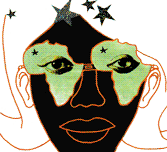
Grapheme # O : Coastline of Africa (Alfredo
Rostgaard / 1972; Bjorn Reiner/ 2004)
Outlining the portrait of Patrice Lumumba,
this grapheme
illustrates how powerful
can be this metaphorical language inherited from Neolithic
Rock
Art.
The
sun-glasses of the Minister of Foreign Affairs offer, thanks to Reiner,
a new vision upon the South-African Woman
Further
pluridisciplinary studies are needed to consolidate our hypothesis
on the role of iconical
graphemes in the emergence of writing.
Concerning basic (non iconical) graphemes
let us note that
at the 25th Valcamonica Symposium, (Proc.pp. 367-372), Kalle Sognnes
presented a communication entitled "Deconstructing
elks",
analysing Rock art engravings from a new non-stylistic
perspective.
Back
.
